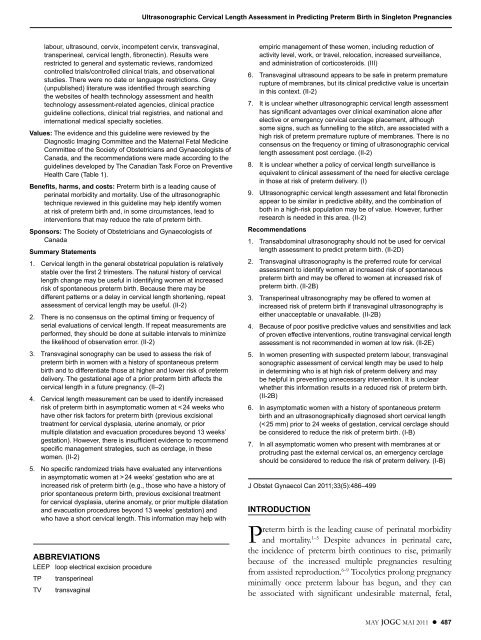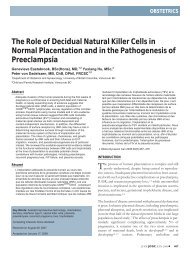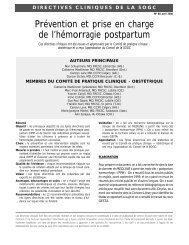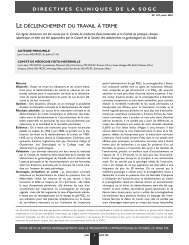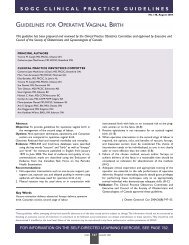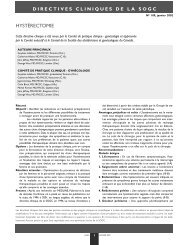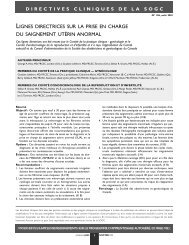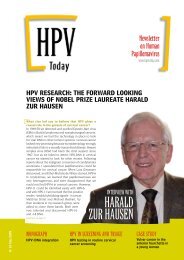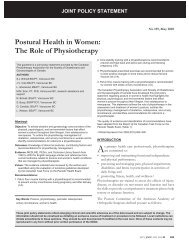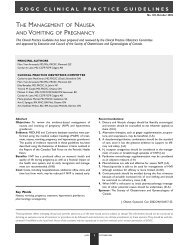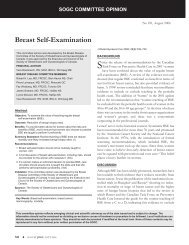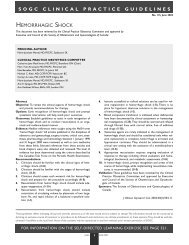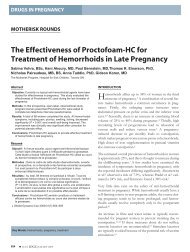Ultrasonographic Cervical Length Assessment in Predicting ... - SOGC
Ultrasonographic Cervical Length Assessment in Predicting ... - SOGC
Ultrasonographic Cervical Length Assessment in Predicting ... - SOGC
Create successful ePaper yourself
Turn your PDF publications into a flip-book with our unique Google optimized e-Paper software.
labour, ultrasound, cervix, <strong>in</strong>competent cervix, transvag<strong>in</strong>al,<br />
transper<strong>in</strong>eal, cervical length, fibronect<strong>in</strong>) . Results were<br />
restricted to general and systematic reviews, randomized<br />
controlled trials/controlled cl<strong>in</strong>ical trials, and observational<br />
studies . There were no date or language restrictions . Grey<br />
(unpublished) literature was identified through search<strong>in</strong>g<br />
the websites of health technology assessment and health<br />
technology assessment-related agencies, cl<strong>in</strong>ical practice<br />
guidel<strong>in</strong>e collections, cl<strong>in</strong>ical trial registries, and national and<br />
<strong>in</strong>ternational medical specialty societies .<br />
Values: The evidence and this guidel<strong>in</strong>e were reviewed by the<br />
Diagnostic Imag<strong>in</strong>g Committee and the Maternal Fetal Medic<strong>in</strong>e<br />
Committee of the Society of Obstetricians and Gynaecologists of<br />
Canada, and the recommendations were made accord<strong>in</strong>g to the<br />
guidel<strong>in</strong>es developed by The Canadian Task Force on Preventive<br />
Health Care (Table 1) .<br />
Benefits, harms, and costs: Preterm birth is a lead<strong>in</strong>g cause of<br />
per<strong>in</strong>atal morbidity and mortality . Use of the ultrasonographic<br />
technique reviewed <strong>in</strong> this guidel<strong>in</strong>e may help identify women<br />
at risk of preterm birth and, <strong>in</strong> some circumstances, lead to<br />
<strong>in</strong>terventions that may reduce the rate of preterm birth .<br />
Sponsors: The Society of Obstetricians and Gynaecologists of<br />
Canada<br />
Summary Statements<br />
1 . <strong>Cervical</strong> length <strong>in</strong> the general obstetrical population is relatively<br />
stable over the first 2 trimesters . The natural history of cervical<br />
length change may be useful <strong>in</strong> identify<strong>in</strong>g women at <strong>in</strong>creased<br />
risk of spontaneous preterm birth . Because there may be<br />
different patterns or a delay <strong>in</strong> cervical length shorten<strong>in</strong>g, repeat<br />
assessment of cervical length may be useful . (II-2)<br />
2 . There is no consensus on the optimal tim<strong>in</strong>g or frequency of<br />
serial evaluations of cervical length . If repeat measurements are<br />
performed, they should be done at suitable <strong>in</strong>tervals to m<strong>in</strong>imize<br />
the likelihood of observation error . (II-2)<br />
3 . Transvag<strong>in</strong>al sonography can be used to assess the risk of<br />
preterm birth <strong>in</strong> women with a history of spontaneous preterm<br />
birth and to differentiate those at higher and lower risk of preterm<br />
delivery . The gestational age of a prior preterm birth affects the<br />
cervical length <strong>in</strong> a future pregnancy . (II–2)<br />
4 . <strong>Cervical</strong> length measurement can be used to identify <strong>in</strong>creased<br />
risk of preterm birth <strong>in</strong> asymptomatic women at < 24 weeks who<br />
have other risk factors for preterm birth (previous excisional<br />
treatment for cervical dysplasia, uter<strong>in</strong>e anomaly, or prior<br />
multiple dilatation and evacuation procedures beyond 13 weeks’<br />
gestation) . However, there is <strong>in</strong>sufficient evidence to recommend<br />
specific management strategies, such as cerclage, <strong>in</strong> these<br />
women . (II-2)<br />
5 . No specific randomized trials have evaluated any <strong>in</strong>terventions<br />
<strong>in</strong> asymptomatic women at > 24 weeks’ gestation who are at<br />
<strong>in</strong>creased risk of preterm birth (e .g ., those who have a history of<br />
prior spontaneous preterm birth, previous excisional treatment<br />
for cervical dysplasia, uter<strong>in</strong>e anomaly, or prior multiple dilatation<br />
and evacuation procedures beyond 13 weeks’ gestation) and<br />
who have a short cervical length . This <strong>in</strong>formation may help with<br />
ABBREVIATIONS<br />
LEEP loop electrical excision procedure<br />
TP transper<strong>in</strong>eal<br />
TV transvag<strong>in</strong>al<br />
<strong>Ultrasonographic</strong> <strong>Cervical</strong> <strong>Length</strong> <strong>Assessment</strong> <strong>in</strong> Predict<strong>in</strong>g Preterm Birth <strong>in</strong> S<strong>in</strong>gleton Pregnancies<br />
empiric management of these women, <strong>in</strong>clud<strong>in</strong>g reduction of<br />
activity level, work, or travel, relocation, <strong>in</strong>creased surveillance,<br />
and adm<strong>in</strong>istration of corticosteroids . (III)<br />
6 . Transvag<strong>in</strong>al ultrasound appears to be safe <strong>in</strong> preterm premature<br />
rupture of membranes, but its cl<strong>in</strong>ical predictive value is uncerta<strong>in</strong><br />
<strong>in</strong> this context . (II-2)<br />
7 . It is unclear whether ultrasonographic cervical length assessment<br />
has significant advantages over cl<strong>in</strong>ical exam<strong>in</strong>ation alone after<br />
elective or emergency cervical cerclage placement, although<br />
some signs, such as funnell<strong>in</strong>g to the stitch, are associated with a<br />
high risk of preterm premature rupture of membranes . There is no<br />
consensus on the frequency or tim<strong>in</strong>g of ultrasonographic cervical<br />
length assessment post cerclage . (II-2)<br />
8 . It is unclear whether a policy of cervical length surveillance is<br />
equivalent to cl<strong>in</strong>ical assessment of the need for elective cerclage<br />
<strong>in</strong> those at risk of preterm delivery . (I)<br />
9 . <strong>Ultrasonographic</strong> cervical length assessment and fetal fibronect<strong>in</strong><br />
appear to be similar <strong>in</strong> predictive ability, and the comb<strong>in</strong>ation of<br />
both <strong>in</strong> a high-risk population may be of value . However, further<br />
research is needed <strong>in</strong> this area . (II-2)<br />
Recommendations<br />
1 . Transabdom<strong>in</strong>al ultrasonography should not be used for cervical<br />
length assessment to predict preterm birth . (II-2D)<br />
2 . Transvag<strong>in</strong>al ultrasonography is the preferred route for cervical<br />
assessment to identify women at <strong>in</strong>creased risk of spontaneous<br />
preterm birth and may be offered to women at <strong>in</strong>creased risk of<br />
preterm birth . (II-2B)<br />
3 . Transper<strong>in</strong>eal ultrasonography may be offered to women at<br />
<strong>in</strong>creased risk of preterm birth if transvag<strong>in</strong>al ultrasonography is<br />
either unacceptable or unavailable . (II-2B)<br />
4 . Because of poor positive predictive values and sensitivities and lack<br />
of proven effective <strong>in</strong>terventions, rout<strong>in</strong>e transvag<strong>in</strong>al cervical length<br />
assessment is not recommended <strong>in</strong> women at low risk . (II-2E)<br />
5 . In women present<strong>in</strong>g with suspected preterm labour, transvag<strong>in</strong>al<br />
sonographic assessment of cervical length may be used to help<br />
<strong>in</strong> determ<strong>in</strong><strong>in</strong>g who is at high risk of preterm delivery and may<br />
be helpful <strong>in</strong> prevent<strong>in</strong>g unnecessary <strong>in</strong>tervention . It is unclear<br />
whether this <strong>in</strong>formation results <strong>in</strong> a reduced risk of preterm birth .<br />
(II-2B)<br />
6 . In asymptomatic women with a history of spontaneous preterm<br />
birth and an ultrasonographically diagnosed short cervical length<br />
(< 25 mm) prior to 24 weeks of gestation, cervical cerclage should<br />
be considered to reduce the risk of preterm birth . (I-B)<br />
7 . In all asymptomatic women who present with membranes at or<br />
protrud<strong>in</strong>g past the external cervical os, an emergency cerclage<br />
should be considered to reduce the risk of preterm delivery . (I-B)<br />
J Obstet Gynaecol Can 2011;33(5):486–499<br />
INTRODUCTION<br />
Preterm birth is the lead<strong>in</strong>g cause of per<strong>in</strong>atal morbidity<br />
and mortality. 1–5 Despite advances <strong>in</strong> per<strong>in</strong>atal care,<br />
the <strong>in</strong>cidence of preterm birth cont<strong>in</strong>ues to rise, primarily<br />
because of the <strong>in</strong>creased multiple pregnancies result<strong>in</strong>g<br />
from assisted reproduction. 6–9 Tocolytics prolong pregnancy<br />
m<strong>in</strong>imally once preterm labour has begun, and they can<br />
be associated with significant undesirable maternal, fetal,<br />
MAY JOGC MAI 2011 l 487


